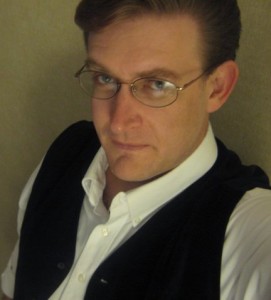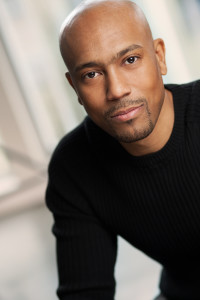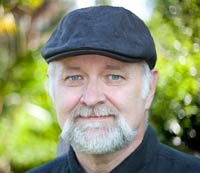A guest post by James A. Owen.
It’s no surprise to anyone who knows me that Walt Disney was and is a continuing influence on my life and work. It was the scope of his ambition as much as anything else that is so inspiring to me: theme parks, film, animation, publishing, and even his business philosophies… There are so many instances where something he did or influenced became a source for inspiring work of my own that the ley-lines of inspiration that connect me to Disney literally touch every part of my life and career.
I’m one of those people who revels in the documentaries about how he began, and built up his company, and especially those about individual projects like the animated films and especially, Disneyland. The animators he called the Nine Old Men were the core of both his original animated masterpieces, as well as his ventures into theme parks, and a lot of that early work was done at the old Hyperion Studio in Los Angeles – a studio which is no longer there. Instead, what stands on the property is a Gelson’s Supermarket. They have some framed photos of the old studio in the market, where I spent a lot of time a decade ago, buying ginger ale and killing time waiting for my agent to call.
At one point, the manager saw me looking out the windows – again – and gently told me that the original studio was completely gone. That there was nothing left of those buildings. I told him I understood, then asked if the studio buildings had faced Hyperion Avenue just like the market did. He said they had. And I replied, “That’s why I’m here. That’s the view they had when they worked on those films.” And he was astounded. Apparently, no one had ever looked up. A lot of people came there to recognize that geographical location – but I wanted to put myself in the shoes of Walt and the Nine Old Men. I wanted to sit at their desks. And The easiest way to do that, and draw on the same inspiration that they drew upon, was to look up, and see the same hills they saw as they worked.
I love the Disney Studios in Burbank for much the same reason. Everyone who visits gravitates towards the Michael Graves-designed executive building with the twenty-foot-high seven dwarves that hold up the roof. The interiors are majestic, the floors, immaculate cold marble. It is austere, and serene, and elegant, and it makes me crazy. I much prefer the old animation buildings, with the faded paint, and linoleum floors (some of which do have carpet, now), and outdated windows and doors – because those were the buildings where Walt and the animators worked. Those were the offices he designed. The feel of those spaces is the feel that brought forth incredible works like Sleeping Beauty, and inspired Walt’s original plans for Disneyland.
The same energies I feel in those old studio locations I feel times one thousand with regards to Disneyland itself. Walt Disney World is bigger and grander in every way – but Disneyland was where Walt wandered around reveling in this great thing he was building and bringing into being. I still have the first Disneyland souvenir book my aunt brought to me, with a back cover that announced a newfangled roller-coaster attraction called Space Mountain. I was told they hardly ever lost anyone in space during the course of the ride. I still wonder. There was a photo of the old cemetery caretaker in the Haunted Mansion that is the direct inspiration for my character Ezekiel Higgins in my StarChild graphic novels and the just-completed book Fool’s Hollow. And Disneyland itself was where I first started writing the book my name and reputation are built upon, Here, There Be Dragons.
I had visited the park several times in my childhood – it was the every-other-year vacation destination for our family – and continued to go as often as I could as an adult. I was involved professionally with a number of people at different divisions of the company, but my real passion was the park itself and the resort environment that radiated from it as the years progressed. I spent a lot of time in Los Angeles a decade ago waiting for meetings on the various projects I was working on, and a few overnight stays closer to the different film studios themselves – basically, Hollywood proper – convinced me I didn’t want to spend any more time in that part of the city than was required by law or my agents. I preferred to make the long drive from and back to Anaheim for the meetings that actually occurred, because that meant that I could spend my free time at the parks, or at the Disneyland Hotel, or in the just-completed Downtown Disney.
There was a bookstore in Downtown Disney – now replaced by an Earl of Sandwich – where I could browse all morning, and there were chairs and tables along greenbelts outside where I could spend afternoons working and reading and dreaming. I could wander the waterfall walks at the Disneyland Hotel – now replaced with bigger swimming pools and a Monorail-themed slide – and there were several restaurants where I could grab a quick soda or slice of pizza to eat.
I couldn’t afford to stay at the nicer hotels, not when I was there for weeks at a time, and so I stayed at an inexpensive motel farther down Harbor, a Rodeway Inn (then called the Vagabond) where I had stayed so often the Bangladeshi family who owned it began referring to me as their “beloved customer.” The first time I was there, I hooked my computer up to the phone for internet, and it dialed my provider – in Arizona. The manager had to tell me I’d spent a couple of weeks worth of deposit on three days worth of internet access by way of long-distance charges, but as I was their beloved customer, they were fine with me mailing a check after I got home.
I stayed at the Vagabond so that I had the proximity to Disneyland, and that was where I wrote much of Here, There Be Dragons. That was where I sat, hoping, dreaming, planning. When I had money, I’d spend a day at the park. When I didn’t, I’d sit outside it, by the roses under the monorail track, where I could watch the train come in at the entrance, and dream more, hope more, and then, go back to the greenbelt or bookstore or room 202 at the Vagabond, which they made sure to give me because it had the biggest desk, and work more.
At one point, I had a presentation that required art, and I needed more space to lay it out than I had at the motel. So I got dressed up in my nicest outfit, went over to the conference center at the Disneyland Hotel, consulted the convention schedule – and which rooms were being used – and simply set everything up in one of the empty rooms. If anyone stuck their head in to ask what I was doing, I’d simply answer “I’m working,” then get back to it. No one bothers someone working in really nice clothes who act as if they belong there. I also learned if you tip the cleaning staff, who never get tips for cleaning conference room space, they’ll be more than happy to pop down to the gift shop and grab a soda for you.
I was in a specific chair at the Disneyland Hotel when I got the news that the producer of the Harry Potter films wanted to option my books. (They didn’t make the movie, but that deal was how I got into the Writer’s Guild and got health insurance.) I worked on a specific bench in the conference center to prepare my presentations for what would become my biggest book deal. I bought the issue of the Hollywood Reporter that announced my first movie deal at the newsstand in Downtown Disney. The first time I saw a copy of Here, There Be Dragons in a bookstore was at the now-gone Compass Books. I celebrated signing the contracts and delivery of the first draft of Fool’s Hollow at two separate dinners with friends and family at the Napa Rose restaurant at the Grand Californian Hotel. I made choices about my career in movies while looking at the candle that they keep lit in Walt’s old apartment over the firehouse in Disneyland. I made decisions about my publishing career standing by the public phones outside the restrooms at the Grand Californian. I first thought of doing window displays of my characters while strolling along Main Street, and created what would become my first animatronics exhibit, part of which will be reemerging at the upcoming Salt Lake Comicon, after reading the big book on Disney Imagineering, in which I also drew the first design for my animatronics walkthrough I took to the San Diego Comicon years ago.
I wanted to be an artist because of the Nine Old Men, and got to meet four of them (Frank Thomas, Ollie Johnston, Ward Kimball, and Eric Larson) and because of the book The Illusion of Life that Frank and Ollie co-authored. I wanted to write adventure stories because of the Uncle Scrooge comics written and drawn by Carl Barks, which I read as a child, and found again as a teenager in huge reprint hardcovers that were produced by a publishing imprint in Scottsdale, whose principals became friends of mine through our shared love of comics. Over the love of those same Barks stories, I became friends with SF author Alan Dean Foster, who wrote an introduction for an issue of StarChild early in my career, and another mutual friend went on to become an animator at Pixar, where I will be going to meet with artists this Fall, and extend the Disney-influenced ley-lines even further.
There are places that are important to us, creatively, because of what they inspire. Sometimes, those places are where other creative did great work. Sometimes, it’s those small connections with people that create the points for the ley-lines. I have an old letterhead – my own – with a message on it written to me by master animator Ward Kimball. When I met him, and we shook hands, he smiled and remarked, “You’ve now touched the hand that touched the hand of Walt Disney.” What made that meaningful to me was that Disney died years before I was born – but one small gesture, one brief comment, gave me a connection to him I treasure.
Every book, every place, every film, every artist, every single connection I have to the things and people Walt Disney influenced have had an influence on me, and the work I do and choices I make. That is a powerful thing. Sometimes, you can’t always see where the ley-lines of creative inspiration connect to the things that were, are, or will be the most meaningful in your life – and you can’t always see where you, and the work you do, and the things and people you influence may be creating ley-lines of influence for someone else. But you are. I promise you, if you do anything creative, you are. And that is hugely, HUGELY, important to me: when someone comes to me and says, “I chose this path because YOU inspired me,” that means something, because I have said those words. I have felt the depth of meaning in them. And I know what they really are: an intersection of ley-lines of something awesome, in a connection that won’t ever be broken. And they’re easier to see than you think – just look up. And keep going. That’s it.
 Guest Writer Bio: James A. Owen is the author of the bestselling Chronicles of the Imaginarium Geographica series, the creator of the critically acclaimed StarChild graphic novel series, and the author of the MythWorld series of novels, the author and illustrator of the forthcoming series Fool’s Hollow, and the author of the nonfiction trilogy called The Meditations. He is also the founder and executive director of Coppervale International, a creative think tank and studio that also publishes magazines and books, and develops and produces television and film projects. He makes his home in Arizona, where he is currently redesigning an entire town. Visit him at heretherebedragons.net and at jamesaowen.com.
Guest Writer Bio: James A. Owen is the author of the bestselling Chronicles of the Imaginarium Geographica series, the creator of the critically acclaimed StarChild graphic novel series, and the author of the MythWorld series of novels, the author and illustrator of the forthcoming series Fool’s Hollow, and the author of the nonfiction trilogy called The Meditations. He is also the founder and executive director of Coppervale International, a creative think tank and studio that also publishes magazines and books, and develops and produces television and film projects. He makes his home in Arizona, where he is currently redesigning an entire town. Visit him at heretherebedragons.net and at jamesaowen.com.



